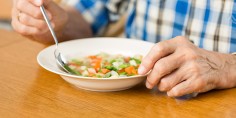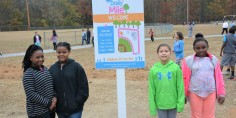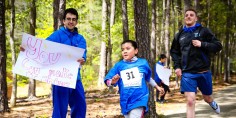In a sunny classroom at Stanfield Elementary School, the second round of Food Pyramid Bingo is in full swing.
Bonnie Winecoff, a community health educator for Stanly Regional Medical Center, calls out the categories. “This is in the fruits and vegetables group: Eggplant. This is in the meat and protein group: Eggs. This is in the milk group: Feta.”
Twenty-five fourth-graders sit at their desks, studying their game cards for a winner. Designed to shed light on nutrition and eating, the game is introducing these North Carolina students to food groups and healthy choices.
“Now this is something you may not have tasted: Tofu,” Winecoff says. “Many people who are vegetarians eat tofu. It’s made of soy and it picks up the flavors of the food it’s cooked with.”
She calls out more categories. “Corn Oil. Plain crackers. Rice milk. Buckwheat pancakes…”
Only winners get a trip to the prize box — but in Stanly Regional’s “Passport to Fitness” program, everyone is a winner. And now, with a $380,000 grant from The Duke Endowment, the expanded effort is helping even more children learn winning habits for a lifetime.
An Action Plan for Good Results
Stanly Regional launched Passport to Fitness in 2003 as a way to encourage exercise and healthy eating and decrease childhood obesity in Stanly County, a rural area just east of Charlotte.
After first targeting fifth graders at 15 schools, Passport to Fitness today reaches more than 4,200 K‑5 students in every public elementary school in the county.
The program works through monthly lessons that focus on a healthy lifestyle. In fourth grade classrooms, Winecoff gives students a chance to taste whole grain foods, calculate resting and moving heart rates, measure the fat and sugar in snacks and create a healthy fast food meal.
For other grades, Stanly Regional prepares activity boxes with lesson plans and materials for classroom teachers.
Winecoff, who has a doctorate in Education Leadership and is a certified Health Fitness Specialist, has conducted Passport to Fitness since its inception. Results have been positive: Students connected to the program maintain or decrease their BMI percentile during the school year.
“We weigh and measure each child at the first of the year and calculate their BMI, their BMI percentile, their weight range and how many pounds they are out of their weight range — and then we measure them again at the end of the term,” Winecoff says. “That’s not enough time for a child to really change their BMI, but it’s enough time for us to realize if they are going up or down or staying the same. And if you can hold the BMI steady while they grow, their chances of being a healthy-weight adult increase.”
The hospital is also offering a new 12-week initiative called ENGERGIZE!, which addresses nutrition, exercise and behavior among children who are at risk for developing Type II diabetes. Modeled on an effort at WakeMed Health and Hospitals in Raleigh, ENERGIZE! identifies children who are at risk of Type II diabetes and provides a family-based healthy lifestyle program to help prevent the disease.
A dozen kids, aged 7 to 13, joined the kick-off group in Stanly County, meeting twice a week for physical activity at a YMCA.






